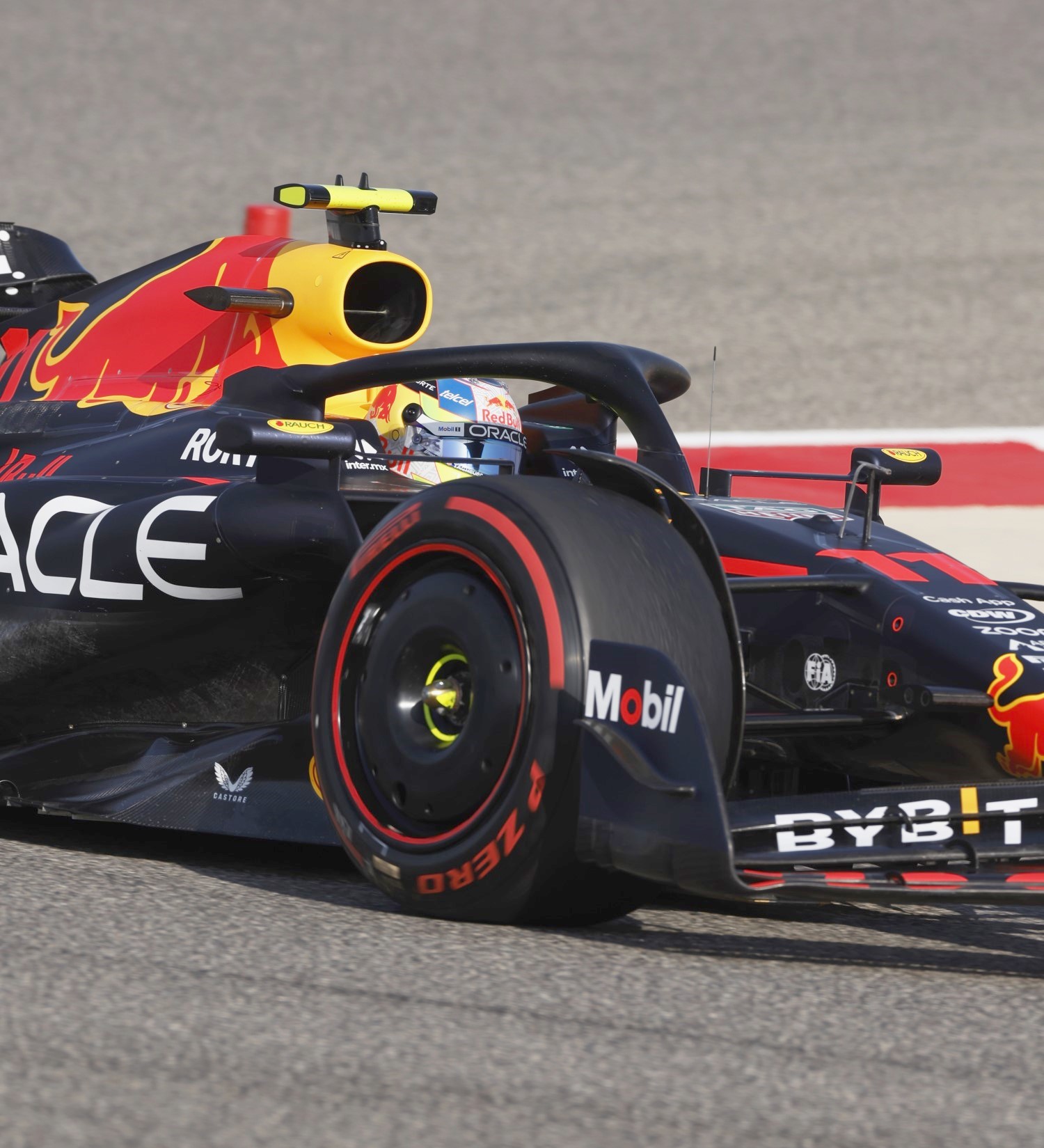F1: FIA publishes long list of upgrades teams brought to Bahrain
All 10 Formula 1 teams submitted their car developments for the season-opening Bahrain Grand Prix and the list is long.
Red Bull
| Updated component | Primary reason for update | Geometric differences compared to previous version | Brief description on how the update works |
| Floor Edge | None | Regulation change enforced a geometry change from last year to raise the minimum height of the outboard edge | It is not a change the team chose to pursue, nor was it beneficial to car performance so the resulting geometry was aimed at minimizing the incurred loss. |
| Front Wing | Performance -Local Load | a subtle evolution of the 2022 item, partially to observe changes to the end plate regulations | given the opportunity to evolve the wing, more load was derived overall without increasing the downstream consequences |
| Coke/Engine Cover |
Reliability | changed the radiator exit ducting necessitating a revised topbody shape. | given the opportunity to optimize the cooling from the data garnered in 2022, the layout has changed subtly and the topbody exit duct has changed to reduce consequences downstream on the exit. |
Ferrari
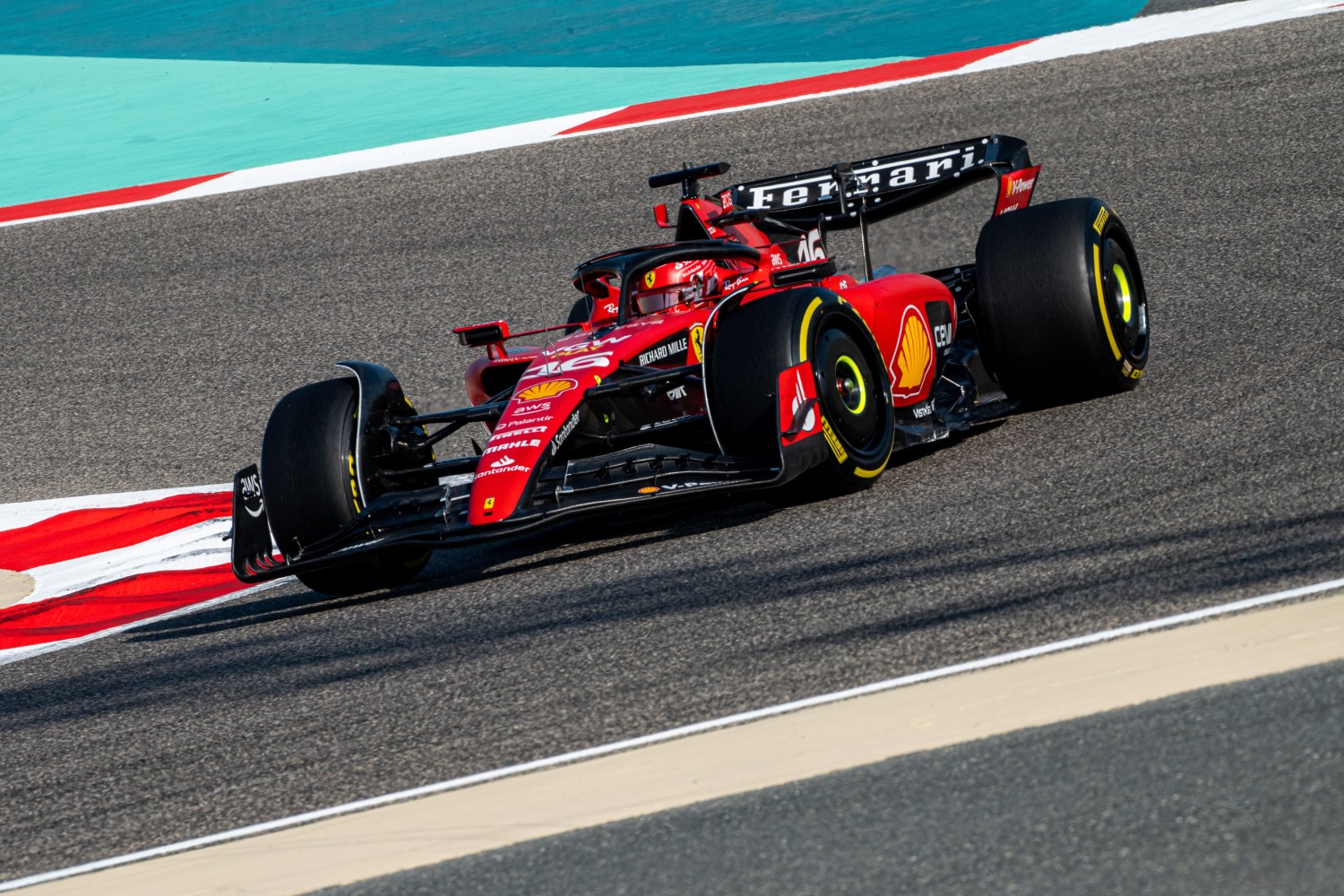
| Updated component | Primary reason for update | Geometric differences compared to previous version | Brief description on how the update works |
| Front Suspension |
None | The most obvious changes to the car are in the area of the front suspension | We have moved from a configuration with a high track rod to one with a low track rod, driven by the demands of the aerodynamics |
| Front Wing | None | The front wing is also different, as is the construction of the nose | The primary element is no longer attached to the nose, instead it is floating |
| Coke/Engine Cover |
None | The bodywork is more a continuation of what was done last year, but it’s more extreme |
Mercedes
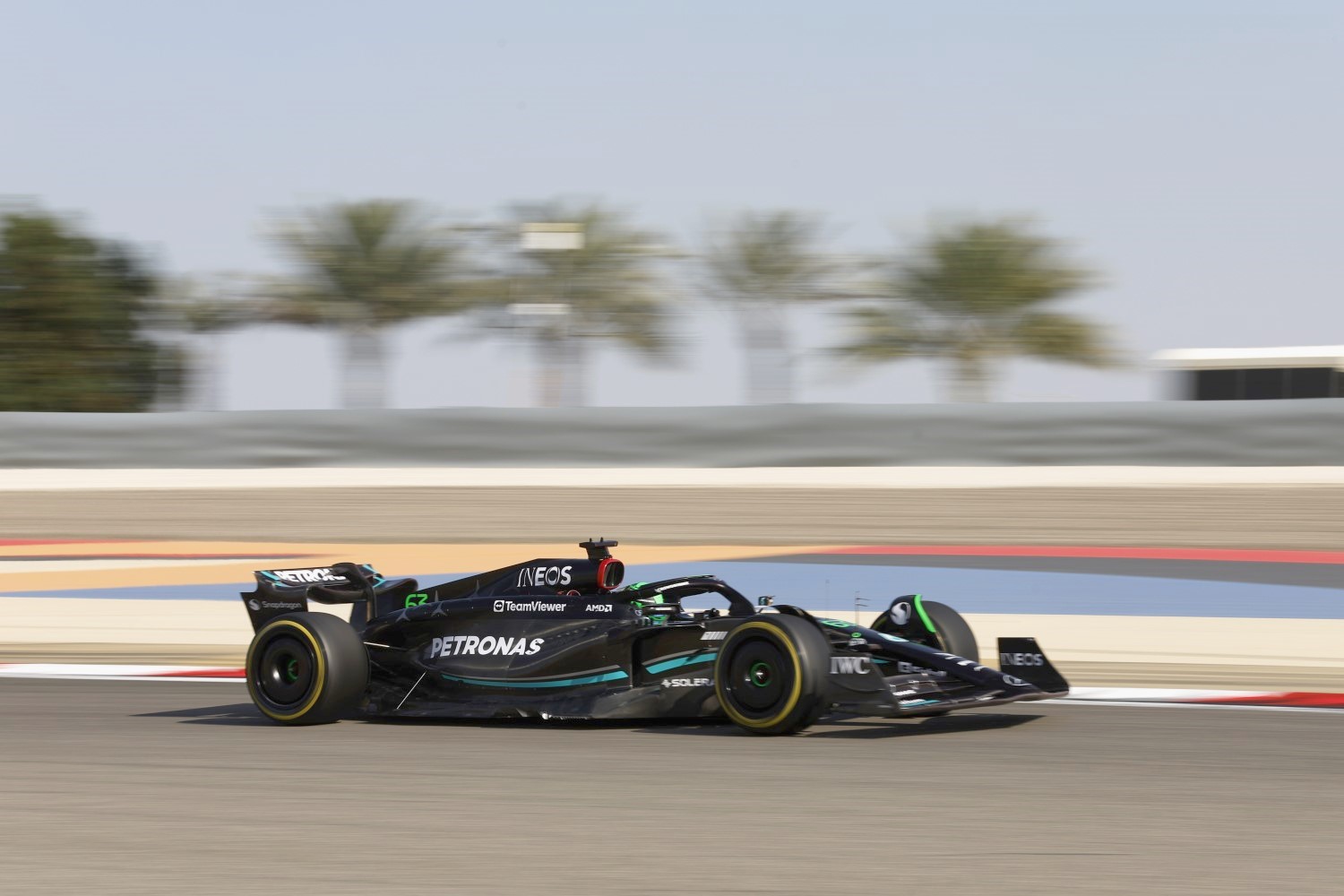
| Updated component | Primary reason for update | Geometric differences compared to previous version | Brief description on how the update works |
| Front Wing Endplate | Performance -Local Load | Introduction of small flicks. | The flicks help focus the vorticity shed from the wing tip vorticity, improving performance over a wider range of front ride heights. |
| Rear Wing | Performance -Local Load | Upper rear wing lifted tips. | Offloading the tip of the wing has shed drag efficiently – this is important for Bahrain and a number of circuits in the early part of the season. |
| Nose | Performance -Flow Conditioning | Re-profiled underside of nose. | Increased front wing local load and improved conditioning of the flow under the chassis and downstream – notably to the underfloor and fences. |
| Floor Edge | Performance -Local Load | New increased camber forward floor edge wing, and reduced chord rear floor edge wing. | Increased forward floor load, and cleaner rear floor edge wing vortex – which in turns increases diffuser load. |
| Sidepod Inlet | Performance -Flow Conditioning | Narrow sidepod inlet. | Improved flow internally to the radiator resulting in more efficient engine cooling; also improved flow to the rear floor edge, providing more rear downforce. |
| Front Suspension | Performance -Flow Conditioning | Front track rod dropped to mid height. | Dropping the track rod has improved the effectiveness of the lower wishbone to turn (downwash) the flow from the front wing for the benefit of the underfloor. |
Alpine
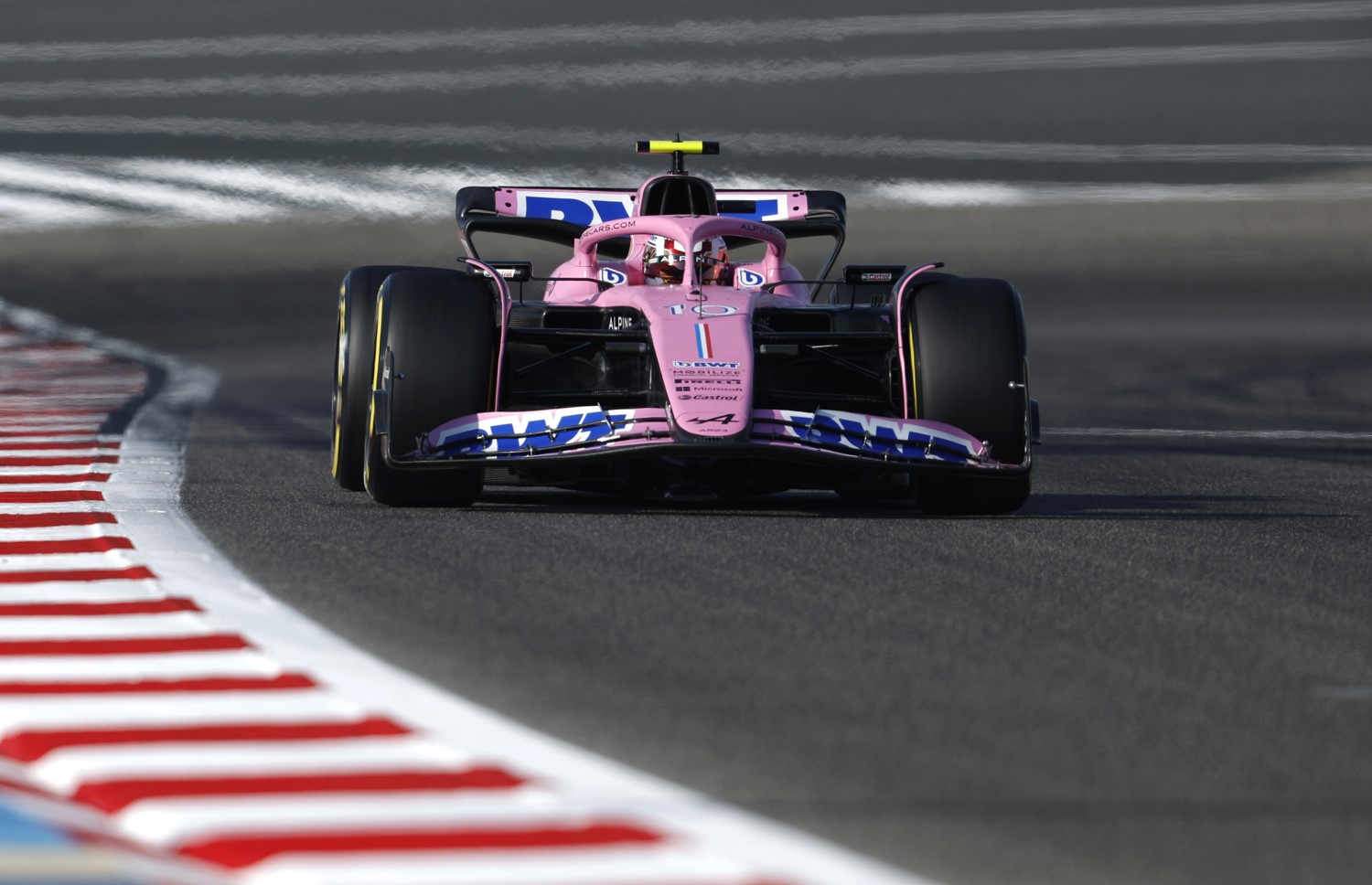
| Updated component | Primary reason for update | Geometric differences compared to previous version | Brief description on how the update works |
| Front Wing | Performance – Local Load |
New component, completely new shape | Increase local load while delivering cleaner air to the back of the car thus bringing more overall aero performance to benefit lap-time |
| Nose | Performance – Flow Conditioning |
New component, completely new shape. | Improve flow structures to the back of the car and, as per above, brings more overall performance |
| Front Suspension |
Performance – Flow Conditioning |
New component, completely new shape. | Improve flow structures to the back of the car to complement the aforementioned supporting areas to bring overall performance |
| Front Corner |
Performance – Local Load |
New component, completely new shape. | Aero development to increase local load as well as an improvement to the front brake cooling configuration |
| Floor Body | Performance – Local Load |
New component, completely new shape. | A key area of development in 2022. Now a completely new floor design, as well as floor fences, underlying floor profile, floor edge and diffuser to improve local load. |
| Coke/Engine Cover |
Performance – Local Load |
New component, completely new shape. | Completely new bodywork shape and cooling exit positions to improve local load and have better flow conditioning to the back of the car. |
| Rear Suspension |
Performance -Mechanical Setup | New component, completely new shape. | New for 2023, pushrod design (not pullrod) to save weight and to better optimise aero development at the rear of the car |
| Rear Corner | Performance – Local Load |
New component, completely new shape. | Improved suspension optimization and brake duct local load as well as brake cooling improvements |
| Beam Wing | Performance – Drag reduction |
New component, completely new shape. | Aero optimization of local load and drag. |
| Rear Wing | Performance – Local Load |
New component, completely new shape. | Aero optimization of local load and drag. |
McLaren
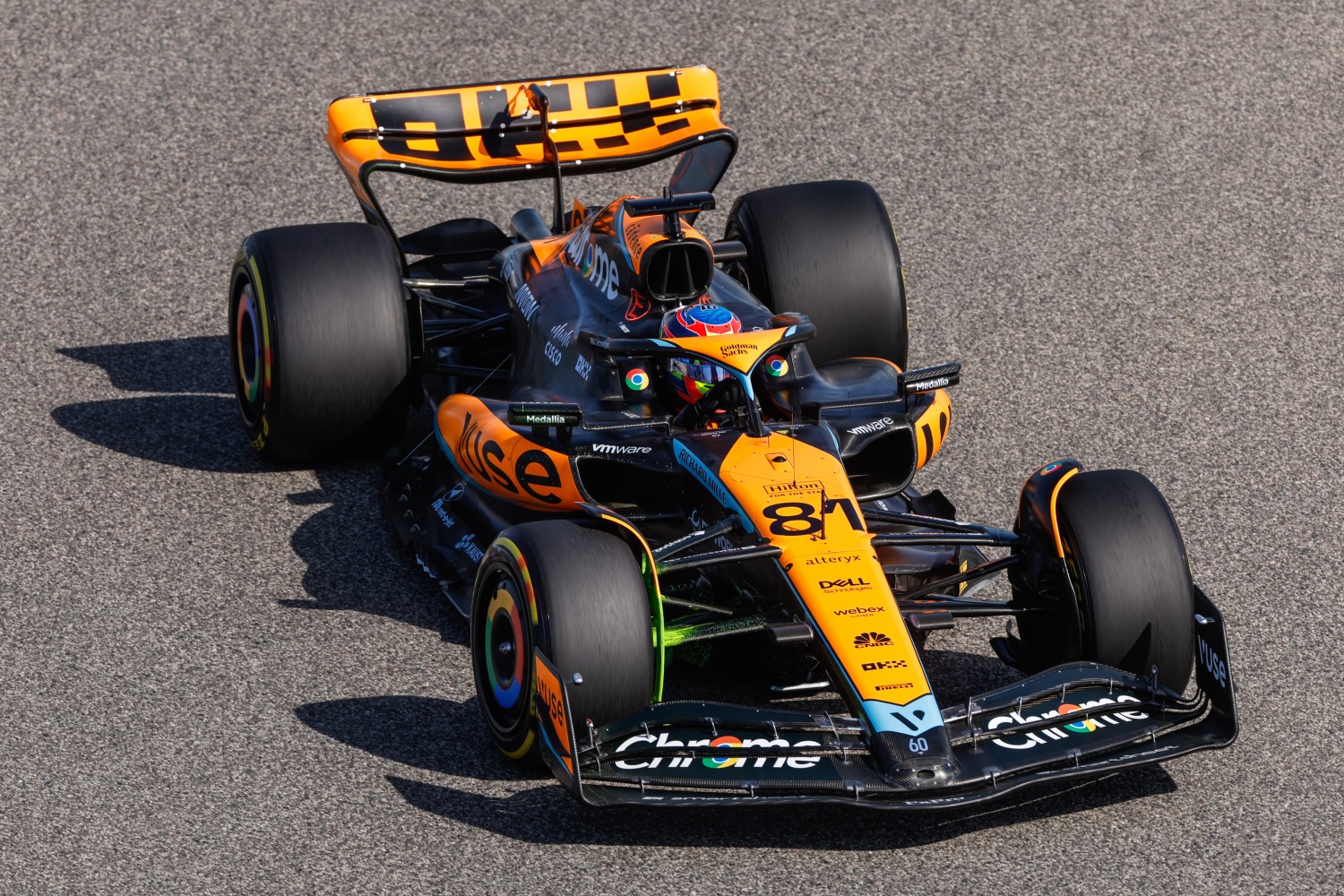
| Updated component | Primary reason for update | Geometric differences compared to previous version | Brief description on how the update works |
| Front Wing | Performance – Flow Conditioning |
Compared to last year’s front wing, the design is completely new. Most visibly the wing has a two-element adjustable flap. | The front wing improves the upstream flow conditions for the car increasing overall car downforce. We moved to a two-element adjustable flap which has a larger aero-balance range. |
| Floor Body | Performance – Local Load |
The floor design is completely new compared to last year. The main redesign is around the outer floor edge which has been raised in height with the 2023 regulations. |
The floor is designed to adapt to the new regulations, add downforce to the car at all car speeds and minimize porpoising. |
| Front Corner | Circuit specific -Cooling Range | The front brake duct design is new both internally & externally. Due to the high braking demands at this event, we will use our high-cooling front brake duct. | The front brake duct is designed to provide the necessary level of brake disc and caliper cooling for high braking demand circuits, whilst minimizing the aerodynamic effect on the car. |
| Sidepod Inlet | Performance – Flow Conditioning |
The bodywork is an evolution of our end-of-season 36A geometry, with a revised sidepod inlet, undercut, and upper sidepod shape. | The bodywork is designed to improve the flow to the rear of the car and increase downforce. A new car design for 2023 has allowed us to package the sidepods in such a way as to allow for a larger undercut. |
| Coke/Engine Cover |
|||
| Cooling Louvres | Performance – Flow Conditioning | The sidepod louvers, which we will run different sizes of, have been moved as part of the new bodywork. | The design, location, and size of the cooling louvers can affect the aerodynamic performance at the rear of the car. The design improves car efficiency when adjusting the cooling level for higher temperature ambient conditions. |
| Beam Wing | Performance – Local Load |
A new beam wing design, most visible around the outboard tips and the junction to the RWEP. | The beam wing design improves efficiency and downforce at the rear of the car, it has different span-wise loading to last years design. |
| Rear Corner | Circuit specific -Cooling Range | The rear brake duct design is new both internally & externally. Due to the high braking demands at this event, we will use our high-cooling front brake duct. | The rear brake duct is designed to provide the necessary level of brake disc and caliper cooling for high braking demand circuits, whilst minimizing the aerodynamic effect on the car. |
Alfa Romeo Sauber
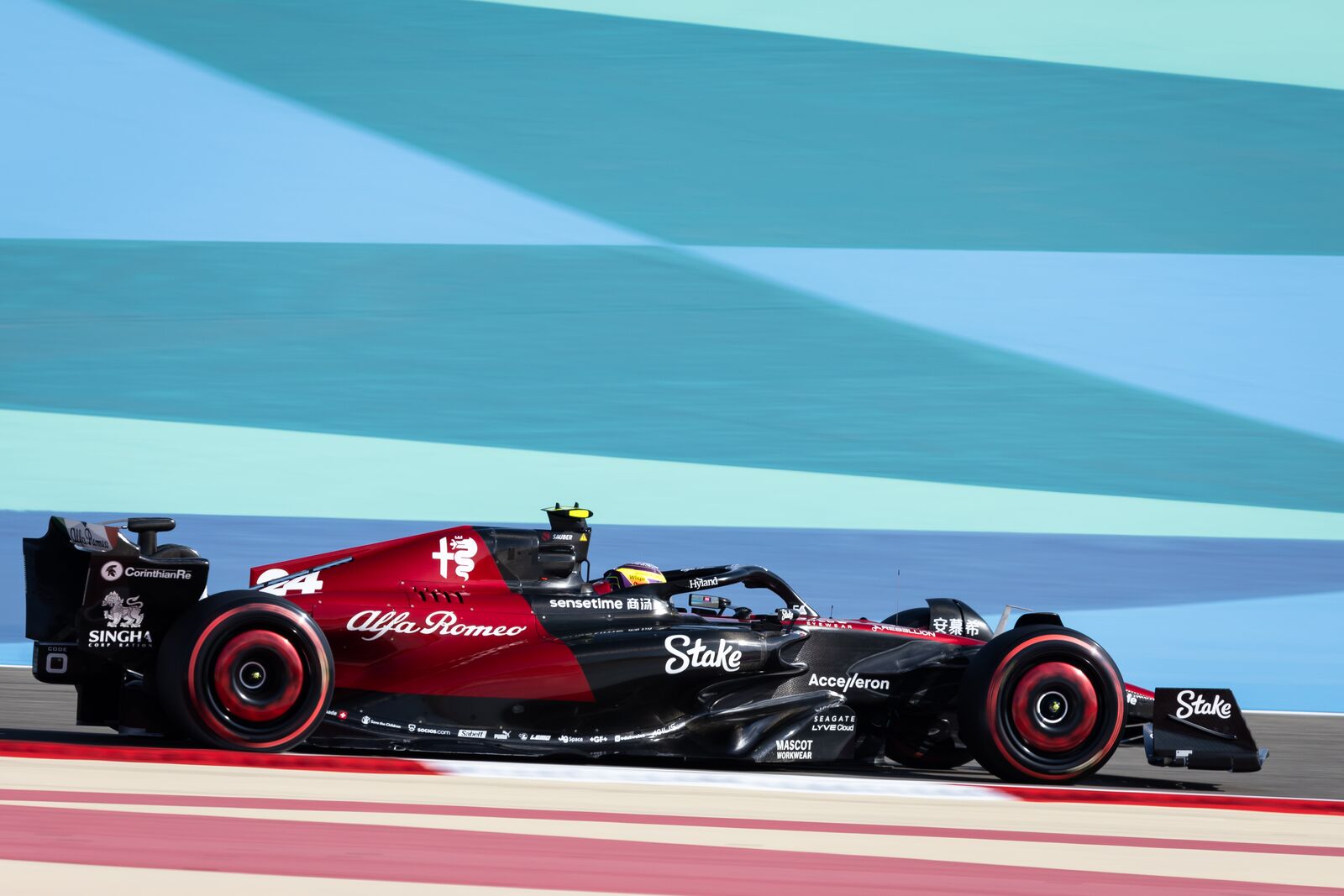
| Updated component | Primary reason for update | Geometric differences compared to previous version | Brief description on how the update works |
| Front Suspension |
Performance -Flow Conditioning |
New for R01: Updated lateral chassis geometry and front suspension covers | The changes to the chassis and front suspension covers help improve airflow traveling down the car and into the sidepod. This should help increase the overall aero efficiency. |
| Floor Body | Performance -Local Load | The entire floor is different including fences, edge, and diffuser. Although similar looking, every surface has changed with a different treatment of the floor edge wing and adaptions to follow the regulation changes for 2023. | The new floor has been designed to improve overall downforce while minimizing the losses caused by the rule changes. |
| Halo | Performance -Flow Conditioning |
There are subtle changes to the shroud around the HALO which now includes a small winglet | The changes aim to reduce losses from the HALO itself whilst also managing other losses created by the cockpit opening |
| Sidepod Inlet | Performance -Flow Conditioning |
The sidepod inlet has a more rectangular entry which is also more swept in plan view. The Mirror has also been updated to comply with the requirement for wider reflective lenses. | The larger undercut below the cooling inlet allows more, high energy, flow to the back of the car to work with the floor edge |
| Coke/Engine Cover |
Performance -Flow Conditioning |
The sidepod, coke and engine cover are completely reworked with a new piggyback cooling duct behind the roll hoop, a larger central exit, and a more sloping top deck | The new bodywork is primarily to package the new central cooler and reduced side coolers. The new design improves flow to the rear of the car |
| Rear Corner | Performance -Flow Conditioning |
The rear brake duct and winglets have been subtly changed but retain last year’s horizontal cooling inlet | The rear brake duct has been tuned to work with the new floor and bodywork concepts minimizing losses and realigning to the new onset flow |
| Rear Suspension |
Performance -Flow Conditioning |
There are only slight changes to the positioning and angles of the rear suspension members as a natural evolution of the pushrod concept already ran in 2022. | The rear suspension has been tuned to work with the new floor and bodywork concepts minimizing losses and realigning to the new onset flow |
| Beam Wing | Performance -Local Load | The new beam wing now transitions from a classic main plane and flap arrangement inboard, to a bi-plain arrangement outboard | The new geometry is designed to work better with the new engine cover central exit increasing local load and efficiency |
Aston Martin
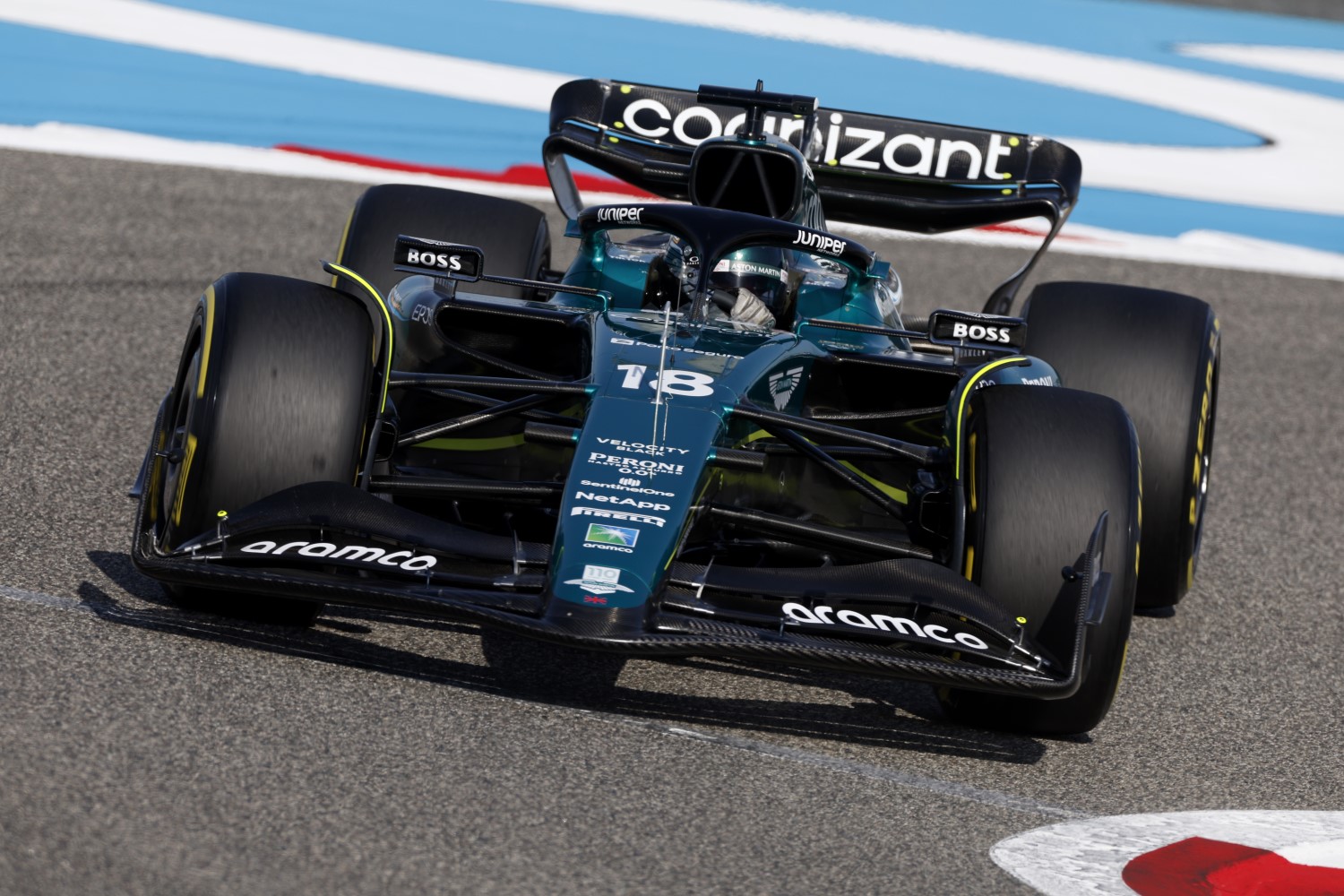
| Updated component | Primary reason for update | Geometric differences compared to previous version | Brief description on how the update works |
| Nose | Performance -Flow Conditioning | The nose tip is lower on AMR23 to suit the lower center section of the front wing, and longer to create a connection to the forward front wing element. | The new nose shape was developed to suit the new front wing design but also has improved flow on the centerline of the car. |
| Front Wing | Performance -Local Load | New design of front wing with lowered center section and revised tip details due to the change in regulations. | Optimized front wing and nose assembly for aero balance adjustment for car setup and wheel wake control through the car operating envelope. |
| Front Wing End plate |
Performance -Flow Conditioning | The front wing end plate tips have changed for revised 2023 regulations. | The end plate geometry is designed to manage the flow around the front wheels and the downstream effect of the wake. |
| Front Suspension |
Performance -Flow Conditioning | Revised front suspension kinematic geometry, with the trackrod lowered compared to 2022. | The external fairings are designed around the new kinematic geometry are aligned to modify the flow around the front wheels. |
| Floor Fences | Performance -Local Load | The 4 fences are now spread more evenly across the span of the leading edge of the floor. | The front of floor has been developed to increase loading in this area to improve the performance as part of the general car development. |
| Floor Body | Performance -Local Load | The main body of the floor is revised modifying the shape of the tunnel along the length of the floor to the diffuser. | The shape changes are to improve interaction with the new fence layout and the changes to the OB edge mandated by the 2023 regulation changes. |
| Floor Edge | Performance -Local Load | Conceptually similar to the end of season configuration, changes have been to small details but this has required complete re-optimization due to the higher floor edge. | The detail changes have been made to regain the load generated in this area after the 2023 regulation changes initially lost performance. |
| Diffuser | Performance -Flow Conditioning | Only significant changes are to the diffuser sidewall and the leading and lower edge details. | Modifications to suit the new upstream flow structures from the higher OB edge and the associated changes aiming to give robust performance through the operating envelope. |
| Sidepod Inlet | Performance -Flow Conditioning | The inlet shape is now more profiled and higher, with the upper leading edge now further rearwards that the lower. | The inlet flow is as clean as possible to effectively cool the car, with the external shape designed to distribute flow to the rear bodywork. |
| Coke/Engine Cover |
Performance -Flow Conditioning | Compared to the ’22 rear bodywork there is now a lower IB channel creating a “gulley”. The central bodywork has a larger, higher TE exit. | The bodywork positions the internal cooling flow to the less detrimental area of the car maximizing good quality to the rear of the car. |
| Cooling Louvres |
Circuit specific -Cooling Range | There are options of cooling options with different amounts of porosity controlled by the effective exit area of the louvres under the untrimmed bodywork. | There are two options of cooling louvre, which can be closed with blanking panels, to exit the minimum amount of internal flow onto the top deck to minimize disruption at the back of the car. |
| Rear Suspension |
Performance -Flow Conditioning | Similar to 2023 but slight modifications to the fairings to suit changes to the internal structural members and revised onset conditions. | Changes in upstream flow quality and direction have required different alignment and relationships between the aero profiles to improve the relationship with the surrounding geometry. |
| Rear Corner | Performance -Local Load | Main focus has been on revision and optimization of the barrel face elements and their layout and profiles, and working on the lower deflector within the scope of the regulation allowance. | The lower deflector changes have improved the management of the rear wheel wake and all elements have changes in response to the change in flow delivered to the area. |
| Beam Wing | Performance -Local Load | Similar in concept to 2022 but optimized profiles and spanwise distribution. | Again, partially in response to new onset conditions the new design has improved efficiency and support for the upper rear wing. |
| Rear Wing | Performance -Local Load | The rear wing is now supported by a single central pylon, remaining changes are profile work and subtle spanwise loading changes. Two flap options are available for car setup. | The rear wing aims to maximize the efficiency of the upper cascade whilst maintaining the largest possible DRS delta when the rear flap is opened. |
| Rear Wing Endplate |
Performance -Flow Conditioning | Multiple small detail changes, some due to more regulation constraint, with the addition of some volume to the OB lower face of the main body. | The upper tip details are to improve the performance of the upper rear wing with the same goals as that device. The lower OB detail improves interaction with surrounding geometry. |
Haas
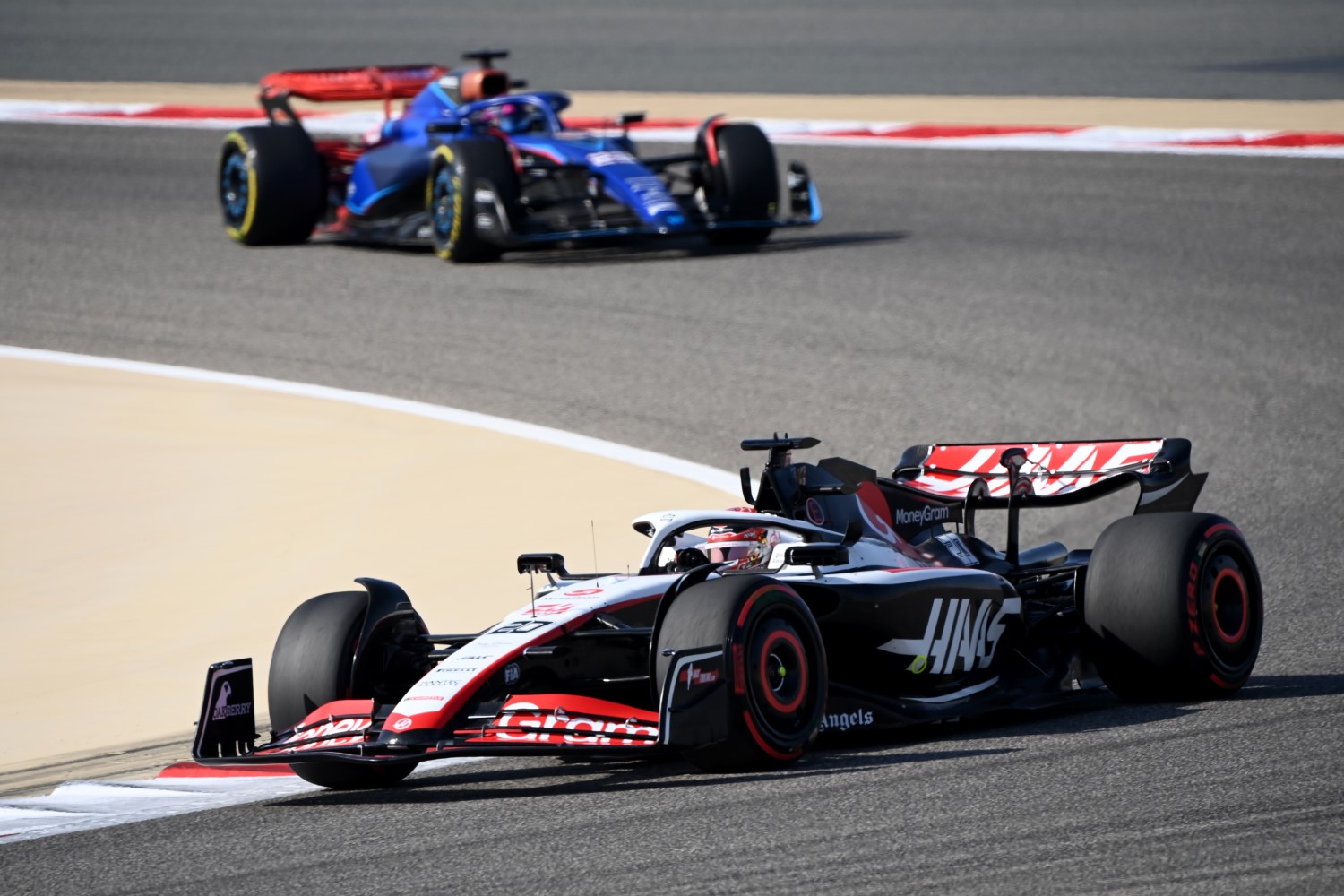
| Updated component | Primary reason for update | Geometric differences compared to previous version | Brief description on how the update works |
| Nose | Performance -Flow Conditioning | Inside the geometrical constraint imposed by FIA and the structural test defined by the technical Regulation, the shape has been improved without a great change in the wing into nose cone attachment. |
The criteria that has been followed in the nosecone shape optimization is to improve the pressure distribution behind the Front Wing and improve the inlet air mass flow toward the front floor. |
| Front Wing | Performance -Local Load | The main dimensions of the four profiles allowed has been optimized in particular respect of the spanwise wing direction. | The improvement of the global efficiency of the car impose a very slim volume of the components a wing is composed, in this way we can get advantage by the phenomena connected to the wheel turbulence structure. |
| Front Wing Endplate |
Performance -Flow Conditioning | New geometries have been explored respecting the complexity of the four profiles that must be cambered upwards and join the top front wing endplate surface. | The interaction of the pressure field generated by the front wing endplate zone and the wheel one, has generated a robust wake with advantages seen even at the rear body too. |
| Front Suspension |
Performance -Mechanical Setup | Few details in mechanical arrangement of the suspension system of the entire car has brought to an optimisation of the aerodynamic effects. | Has been optimised the aerodynamic structure of the suspension legs with advantages at the correct working of the front wing and the improvement of the impact of the flow towards the front part of the floor. |
| Floor Fences | Performance -Flow Conditioning | The front floor fence design has been improved getting advantages from the deep investigation done in wind tunnel and with Computation Fluid Dynamics simulations with last year Haas Configuration. | Our research direction has been to maximise the combination of surface contraction imposed by the regulation in this area with the effect of washing out used even when regulation was allowing the bargeboard. |
| Floor Body | Performance -Local Load | The evolution of the volume generated by the car floor and the ground at the different car attitudes has been revisited. | A correct and balanced contraction and expansion has resulted to be as one of the key rule to provide efficiency at the entire car aerodynamic package. |
| Front Corner | Circuit specific -Cooling Range | New combination of scoop and internal ducting shape investigation has taken a great portion of our time in the beginning and in the final part of our 2023 car definition. | In addition to the cooling optimization a deep attention has been taken for the influence that the front corner bodywork have on the front wing tip |
| Cooling Louvres |
Circuit specific -Cooling Range | The intention of the designers has been to introduce new ideas for the cooling system. The entire package around the Ferrari power-unit was studied in all its details. |
With several loop of simulation and correlation work the complex package composed by several elements dedicated to the heat transfer has been investigated with the aim to improve cooling management. |
| Diffuser | Performance -Local Load | Keeping in mind that the diffuser is one of the car component that most contribute to the car aero efficiency, an optimization starting from the experience gained last year has been conducted. | No elements of the diffuser or its surfaces has been maintained from the 2022 car. Beam wing and diffuser trailing edge are developed together to gather the maximum expansion at the rear of the car. |
| Rear Suspension |
Performance -Flow Conditioning | New rear suspension and shape has been introduced with the aim to improve the tyre use management and the aerodynamic of the diffuser. | The structural and kinematic constraints, oblige not to push over some limit the aerodynamic requirement at the car rearend. Nevertheless a new lay out has been found that represent a significant step forward in the car performance respect the previous model. |
Scuderia AlphaTauri
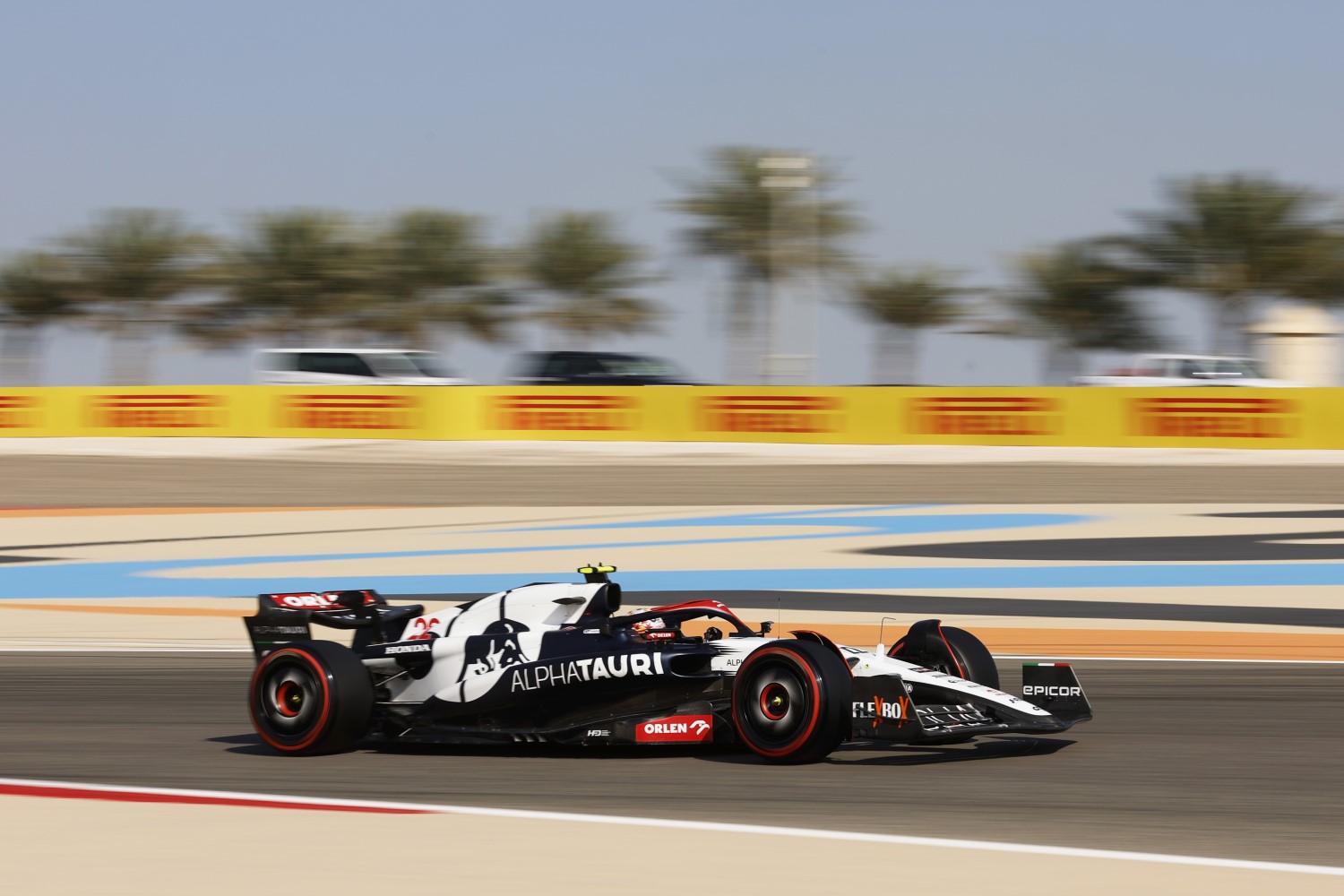
| Updated component | Primary reason for update | Geometric differences compared to previous version | Brief description on how the update works |
| Nose | Performance -Flow Conditioning | The AT04 nose is significantly narrower than on AT03 and reprofiled. It features lower surfaces that integrate smoothly with the lower surface on the front wing mainplane. | The narrower and more integrated nose is used to reduce the loss from the nose and inboard sections of the FW that eventually pass under the floor and hamper its performance. The sectional shaping is designed to enhance the pressure field created by the front suspension. |
| Front Wing | Performance -Local Load | The inboard sections of the FW have been reduced in chord producing an aggressive sweep to the elements in plan view as they increase in chord towards the endplate. | The shorter inboard sections work in conjunction with the nose surface to better condition the flow to the floor. The changes also place the loss from the FW in a better place in relation to the front suspension elements than seen on AT03. |
| Front Suspension |
Performance -Flow Conditioning | The angles of the planes of both the front top wishbone and front lower wishbone have become more aggressive. The fairings at the inboard and outboard end have also been adapted to improve the aerodynamic quality. | The changes in angle of the suspension legs and fairings improves the onset condition of the flow to the floor. They also help to control the loss that is ejected from the wedge where the tyre makes contact with the ground. A loss we call the ‘squish loss’. |
| Front Corner | Performance -Flow Conditioning | On AT04 the entire front brakeduct has been redesigned. The scoop itself features a downwashing and outwashing aspect and has been raised to remove the intersection with the front lower wishbone seen on AT03. | Removing the intersection with front lower wishbone exposes more of the surface of the wishbone to generate the desired pressure field to control the front tyre wake. The shaping of the brakeduct scoop itself is designed to enhance this effect whilst also improving the loss at the junctions between it and the wishbone legs in comparison to AT03. |
| Floor Body | Performance -Local Load | The AT04 floor features a raised inboard leading edge and completely reprofiled underside compared to the AT03. The forward outboard edge features a radius detail that is legalised via a solid wire at the periphery of the floor. Due to its appearance we have named this feature the ‘cheese wire’. |
The underfloor profiling is designed to make best use of the vorticity generated by the floor fences and maximise the downforce generated by the floor’s close proximity to the ground. The leading edge height change was done to improve performance in a specific part of the ride height envelope of the car that we felt we were weak in last year. Applying the blend detail to the edge of the floor alters the base pressure that the outboard of the fence system sees helping us improve the underfloor vorticity. |
| Floor Edge | Performance -Local Load | The floor edge features a similar floor edge wing to AT03 but it has been redesigned to incorporate three vanes. The rearward edge has been raised in accordance with the 2023 regulations but maintains a similar ‘straight cut’ philosophy as AT03. |
The vanes enhance the outwash of the floor wing helping lower the pressure under the floor. They also form vortices that further improve floor loading downstream. |
| Diffuser | Performance -Local Load | A cut out in the sidewall is the main change to the diffuser on the AT04. | The cut out allows higher quality flow from outside of the floor to enter the diffuser and re-energise the flow under the floor. |
| Sidepod Inlet | Performance -Flow Conditioning | The sidepod inlet has been reduced in height on the AT04 and raised with the OB extremity swept rearwards. This widens the inlet to maintain its area. | Maintaining the inlet size is important in achieving the necessary flow rate to the radiators to cool the car. The raised inlet increases the size of the ‘undercut’ which allows it to feed better flow to the floor edges downstream to increase their loading. |
| Coke/Engine Cover |
Performance -Flow Conditioning | The top of the engine cover has been dramatically reduced in volume compared to the AT03 which is aided by a tightly packaged and smaller central radiator on the AT04. The rearward exit has also been raised. |
The shrinking of the upper engine cover and the raising of the exit has been done to reduce local lift and improve the onset flow to the rear wing and lower beam wing to allow them to generate more downforce more efficiently. |
| Cooling Louvres |
Performance -Flow Conditioning | Compared to the AT03 the number of louvres has increased and they have moved around the shoulder of the upper engine cover to sit more on the top shelf. | The reprofiling and repositioning of the louvres improves the loss that exits from these apertures but also places this loss in a position at the rear of the car that is less damaging for the performance of the beam wing and rear wing. This helps to improve the efficiency of this cooling option. |
| Rear Wing Endplate |
Performance -Local Load | The leading edge of the rear wing endplate has moved nose in but then shaped to maintain the span of the beam wing. |
The change better aligns the endplate but also allows increased clearance to the flow features from the rear brakeduct and winglet. As the span reduction of the beam wing is minimal it allows the overall load of the rear wing assembly to increase. |
Williams
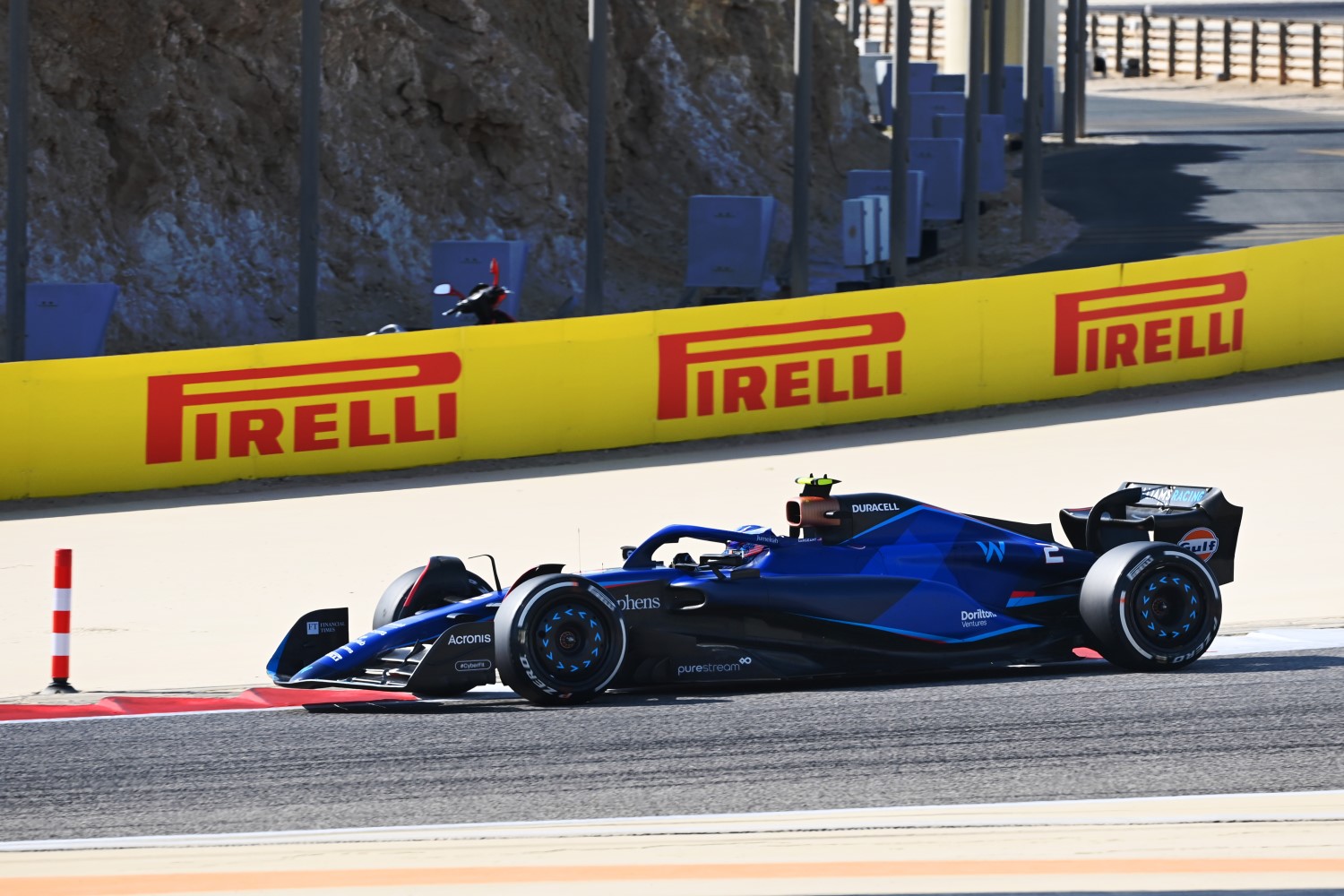
| Updated component | Primary reason for update | Geometric differences compared to previous version | Brief description on how the update works |
| Nose | Performance – Flow Conditioning |
The nose now joins to all of the front wing elements (on FW44 it did not join to the leading element) | |
| Front Wing | Performance – Flow Conditioning |
There are minor changes to the location of the slot gap separators between the front wing elements | These are a combined structural and aero improvement to deliver higher quality air flow further down the car |
| Front Wing | Performance – Local Load |
The rearward two elements of the front wing have revised profiles and now feature a more pronounced change in spanwise geometry. There are subtle updates to the geometry where the elements join the endplate. | These updates generate more load on the front wing and also deliver cleaner flow further down the car, including into the radiator ducts and the new sidepod undercut |
| Front Suspension |
Performance – Flow Conditioning |
The overall layout of the suspension links is unchanged, however, the inclination and height of each has been adjusted. | In combination with the revised brake ducts scoops, the suspension reduces losses and interaction with the wing wake relative to FW44. |
| Front Corner | Performance – Flow Conditioning |
The front brake duct inlet scoop is significantly reduced in size and is now taller and narrower. There are also changes to the internals of the brake duct system, which delivers the required level of brake cooling despite the smaller inlet | The total brake duct system offers sufficient and efficient brake cooling (disc and caliper) and also improves the tyre wake control and works in conjunction with the suspension link updates to produce some additional local load and improved flow down the car. |
| Coke/Engine Cover |
Performance – Flow Conditioning |
The radiator inlet ducts are very similar to those on the end-of-season FW44. However, by relocating the side impact structure tube (lower) and resizing/repositioning the radiators, the sidepod and engine cover now features a much more aggressive undercut. There is also a more elaborate upper profile to the sidepod. Whilst the detail will vary according to the circuit cooling requirements, the central exit of the engine cover is typically larger than on FW44 |
The more aggressive undercut works in conjunction with the entire rearward system on the car, including the new floor edge details, diffuser and outboard brake duct winglet cascade. The undercut delivers higher energy flow to these regions for improved load. The engine cover shape better accommodates the cooling louvre options so that we lose less aero performance as we increase the cooling flow through the radiator system |
| Rear Wing | Performance – Local Load |
Revised aerofoil profiles to the upper elements. Revised pylon mounting geometry. Increased geometric detail where the upper elements meet the rear wing endplate | The upper elements produce more load and work in conjunction with the revised beam wing arrangement. The pylon geometry is better for local flow control and provides the required stiffness to hold the upper elements in place. |
| Beam Wing | Performance – Local Load |
More aggressive, highly loaded beam wing upper and lower elements | These profiles work with the updated rear wing elements described above. The produce additional load locally and also improve the rear wing – diffuser system to further improve the load. |
| Halo | Performance – Flow Conditioning |
There are minor updates to the mirror (legality) and rearward HALO furniture as well as a minor reprofiling and resizing of the roll hoop inlet | These features better condition the flow coming over and round the cockpit before it feeds the engine cover upper surface and the rear wing system. The roll hoop inlet ensures compliance with the mandated chassis safety tests and also feeds the central radiators with sufficient quantity and quality of air flow. |
| Floor Fences | Performance – Flow Conditioning |
The floor fences are realigned to the local flow. The outboard fence is extended further forward, towards the front tyre | These fences help condition the flow as it progresses along the floor and to the diffuser |
| Rear Suspension |
Performance – Flow Conditioning |
The lower wishbone and toelink incidence are changed relative to FW44 | This improves the section alignment with the local flow and works in conjunction with the revised winglet cluster to generate increased local load |
| Rear Corner | Performance – Local Load |
The number and arrangement of the winglet cascades is changed with a larger number of smaller winglets present on FW45. The inlet and exit of the brake duct scoop are wider and shorter on FW45. |
This system works with the realigned wishbone and toelink to improve wake management and generate more local load |
| Front Suspension |
None | The geometric differences are driven by aero requirements (see above) but there are small changes to the suspension kinematics as a result | |
| Floor Edge | Performance – Local Load |
The spat edge is raised in accordance with the FW45 Tech Regs. The local details have increased in complexity and include a cutout containing a small wing element. | Legality. The changes to the floor edge detail are aimed at recovering as much of the load lost due to the height change as possible. There is also a detail to improve the state of the spat vortex, which improves the load delivery of the total rear system |
| Diffuser | Performance – Local Load |
The kickline height is raised in accordance with the FW45 Tech Regs. There are further modifications to the central diffuser geometry rearward of the spat region. |
Legality. The changes to the diffuser geometry improves control of the wheel wake, works in conjunction with the revised lower beam wing to produce improved load throughout the wing:diffuser system |
